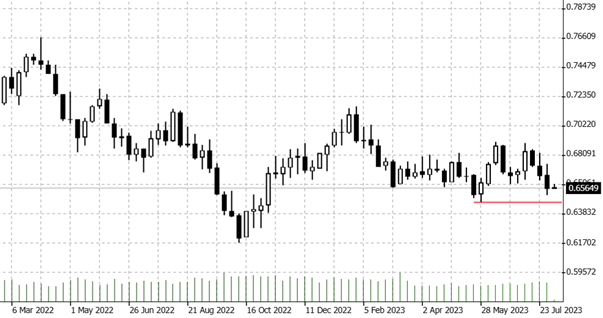

07.08.2023 – Is there really such a thing as seasonal patterns in Forex trading? We found an author who says there is. And he advises to keep an eye on the Australian dollar in August. We’ll abstain from an opinion and briefly summarize the thesis.
If Don Dawson of the financial website “Barchart.com” has his way, we are in the middle of a very interesting phase for the Aussie. He just wrote “Stop Wasting Time And Start Comprehending The Australian Dollars Seasonal Trading Pattern In August.” Dawson believes that if the weekly chart breaks below the May 31 low, it will support the “August seasonal sell pattern”. Here is the weekly chart of AUDUSD.

Source: Bernstein Bank GmbH
The Moore Research Center found that AUD traditionally tends to weaken before the end of Australia’s first fiscal quarter on Sept. 30 – over 15 years, this pattern has produced gains 87 percent of the time. On August 24, for example, the Aussie had closed below its August 04 level in 13 of the past 15 years. Of course, this past pattern does not guarantee success in the future, the author qualified.
Will spring bring a bull market?
Improved economic data can only be expected in Australia from September onwards – because that is when spring begins, which has a positive effect on the job market, growth in gross domestic product and business surveys. Dawson’s thesis: “Longer daylight hours and warmer weather often stimulate economic growth.” Of course, commodity prices are also important for the performance of the foreign exchange – as the country continent exports iron ore, gold or coal.
Looking at monetary policy
Dawson went on to say that the market could be oversold at the moment and need a rally to provide a better entry point for the short trade. He added that this is also due to monetary policy. He said the Reserve Bank of Australia (RBA) has just delayed reaching its inflation target of 2 to 3 percent until late 2025. This has supported the Aussie.
However, the market had expected an interest rate step of 25 basis points – but for the second time in a row, the RBA paused. First, the central bank wanted to analyze the effect of earlier interest rate steps. In the end, hawkish and dovish comments balanced each other out – “which may assist our upcoming seasonal sell in the AUD.”
We are curious to see how the predicted seasonal sell develops – and wish successful trades and investments!
____________________________________________________________________________________________________________
The content of this publication is for general information purposes only. In this context, it is neither an individual investment recommendation or advice nor an offer to purchase or sell securities or other financial products. The content in question and all the information contained therein do not in any way replace individual investor- or investment-oriented advice. No reliable forecast or indication for the future is possible with respect to any presentation or information on the present or past performance of the relevant underlying assets. All information and data presented in this publication are based on reliable sources. However, Bernstein Bank does not guarantee that the information and data contained in this publication is up-to-date, correct and complete. Securities traded on the financial markets are subject to price fluctuations. A contract for difference (CFD) is also a financial instrument with leverage effect. Against this backdrop, CFD trading involves a high risk up to the point of total loss and may not be suitable for all investors. Therefore, make sure that you have fully understood all the correlating risks. If necessary, ask for independent advice. CFDs are complex instruments and are associated with the high risk of losing money quickly because of the leverage effect. 68% of retail investor accounts lose money trading CFD with this provider. You should consider whether you understand how CFD work and whether you can afford to take the high risk of losing your money.7
